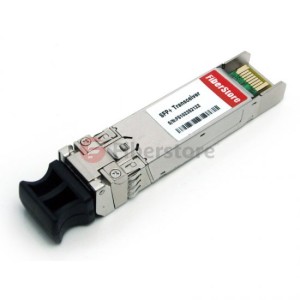Pluggable optical transceivers were introduced initially in datacom as advanced version of fixed transceivers. However, the advantages of pluggability and the small form factor were so appealing that telecom transceivers were introduced very soon. There are a plethora of standard transceiver formats, but at present only two are really used in the telecommunication environment, the others being either confined to datacom application or completely substituted by more advanced formats: small form-factor pluggable SFP and XFP transceivers. Thus we will talk in details only about these two standards.
The SFP is the more compact optical transceiver used in optical communications. It interfaces a network equipment mother board to a fiber-optic or unshielded twisted pair networking cable. This is probably the most diffused transceiver format available with a variety of different transmitter and receiver types, allowing users to select the appropriate transceiver for each link to provide the required optical reach over the available optical fiber(e.g multimode fiber or single mode fiber).
A drawing of an SFP transceiver is presented, where the particular connector for the input and output fibers that, with different dimensions, is present in all the transceivers is evidenced. The way in which the SFP transceivers are hosted on the motherboard using a suitable cage allowing a hot plug, where both the empty cages on the front of a system card and the cage with pluggable SFPs are shown.
Optical SFP modules are commonly available in four different categories: 850 nm (SX), 1310 nm (LX), 1550 nm (ZX), and WDM, both DWDM SFP and CWDM SFP. SFP transceivers are also availble with a “copper” cable interface, Such as 10G copper SFP, allowing a host device designed primarily for optical fiber communications to also communicate over unshielded twisted pair networking cable.
Commercially available fiber optic transceivers have a capability up to 2.5 Gbit/s for transmission applications; moreover, a version of the standard with a bit rate og 10Gbit/s exists, but it can be used only to connect nearby equipment, and is very useful to spare space and power consumption as interface in the client cards of line equipments.
Modern optical SFP transceivers support digital optical monitoring functions according to the industry standard SFF-8472 MSA. This feature gives the end user the ability to monitor real-time parameters of the SFP, such as optical output power, optical input power, temperature, laser bias current, and transceiver supply voltage. And we should have some understanding of some well-known electronic communications company, Cisco SFP Transceivers, Dell SFP Transceiver, D-Link SFP Transceiver, HP SFP Transceiver , Finisar SFP Transceiver and so on.
SFP transceivers are designed to support SONET, Gigabit Ethernet, Fiber Channel, and other communications standards. The standard is expanding to SFP+ (SFP plus) transceivers, which will be able to support data rates up to 10.0 Gbit/s (that will include the data rates for 8 Gbit Fiber Channel, and 10GbE). For example, there is a series of SFP+ Transceiver Module in Fiberstore is very popular. The SFP-10G31-10-FI series single mode transceiver is small form factor pluggable module for serial optical data communications 10GBASE-LR/LW. It is with the SFP+ 20-pin connector to allow hot plug capability. This module is designed for single mode fiber and operates at a nominal wavelength of 1310 nm.
The MSA for the XFP transceiver was born after the start of the success of the SFP format to provide a transceiver with a form factor suitable to host 10 Gbit/s transmission components, but sufficiently compact to reproduce the advantage of the SFP.
Thus, at present, there are a large number of different XFP transceivers designed for telecommunications: from the transceivers with gray short-reach interface for application in the client ports of optical equipments to short, intermediate, and long-reach DWDM XFP interfaces, tunable DWDM XFP, both with fixed and tunable lasers, to CWDM 10G transceivers.





